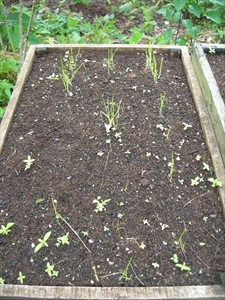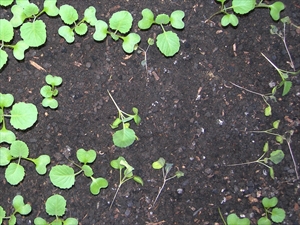Damping-off
Pacific Pests, Pathogens and Weeds - Online edition
Pacific Pests, Pathogens & Weeds
Damping-off (047)
Commonly, Pythium and Rhizoctonia are involved, but Fusarium and Phytophthora may also cause similar diseases. Note, Pythium and Phytophthora are not fungi but water moulds or oomycetes, related to algae.
Worldwide. The fungi that frequently cause damping-off are present throughout Oceania.
Many kinds of fruit and vegetable seedlings show the disease in the nursery, with beans, cabbage, carrot, lettuce, onion, and tomato especially susceptible.
The fungi and water moulds involved in damping off are widely distributed in soil. They live on organic matter, but also on the roots of living plants as parasites. Pythium and Phytophthora prefer wet soil conditions, and have spores that swim in soil water. By contrast, Rhizoctonia and Fusarium, do not survive well in wet soils.
Seedlings are attacked by damping-off fungi and water moulds (Pythium and Phytophthora are not fungi) either before they emerge (called pre-emergence damping off) or after (called post-emergence damping off) (Photos 1-3).
Plants that are growing poorly, because the soil is waterlogged or the temperature is unsuitable, are more likely to be infected by damping-off fungi and water moulds, in contrast to those seedlings growing rapidly.
Spread of these fungi and water moulds occurs in water splash, on contaminated tools, in potting mixes and in the roots of infected plants.
Damping-off is a serious disease affecting most seedlings of vegetables. There are two kinds: (i) pre-emergence damping off results in gaps in the rows of seedlings, whereas (ii) post-emergence damping off results in seedlings that fall over due to root rots and stem infections, often at soil level. Those that survive the attack may be stunted, or grow slowly.
Seedlings that have strong stems, such as cabbages, do not always fall over; the plants have thin, twisted, discoloured stems (known as 'wire stem'). If the infection girdles the stem, the seedlings die eventually.
Look for gaps in the row and, if present, look to see if the seed is decayed. Look for seedlings that have emerged and then fallen over due to soft rots on the stem or decayed roots. Look for lesions and cankers (open lesions) on seedlings with strong stems. Threads of fungi (e.g., Rhizoctonia) and water moulds (e.g., Pythium and Phytophthora) may be present over the soil and seedlings, and visible with the naked eye.
CULTURAL CONTROL
Cultural control is important. The following should be done:
- Sterilise the soil mix:
- Heat the soil in an earth oven over hot stones covered in leaves or sacks for at least one hour, or
- Place the soil mix in boxes or place it on the ground between bamboo sections, and pour boiling water over the soil.
- Keep the treated soil in clean bags until it is used, to prevent reinfection from water splash or contaminated tools.
- If outbreaks of damping-off occur in seedbeds, move the beds to a different site.
- Water soil and plants with rain water, not with water from ponds or streams.
- Do not overwater seedlings; ensure the seed boxes have good drainage.
- Raise nursery seed boxes above ground level (at least 1 m) to avoid rain splash from the soil.
- Always use a nutritious soil mix: rotten coconut mixed with soil is best. If using home-made compost (from household scraps and/or 'green' matter) make sure it is well rotted before mixing it with the grated coconut.
RESISTANT VARIETIES
It is unlikely that any of the common vegetable varieties would differ in their susceptibility to damping-off.
CHEMICAL CONTROL
If cultural controls fail, treat seed with a fungicide, such as mancozeb, or thiram. Fungicide can also be used to treat seedbeds and/or seed boxes. Bleach can also be used to sterilise pots and seed boxes; dilute to about 1% sodium hypochlorite, and wash well after treatment.
____________________
When using a pesticide, always wear protective clothing and follow the instructions on the product label, such as dosage, timing of application, and pre-harvest interval. Recommendations will vary with the crop and system of cultivation. Expert advice on the most appropriate pesticides to use should always be sought from local agricultural authorities.
AUTHORS Helen Tsatsia & Grahame Jackson
Information from Grabowski M (2018) How to prevent seedling damping-off. University of Minnesota Extension. (https://extension.umn.edu/solve-problem/how-prevent-seedling-damping); and DAF (2014) Damping off. Queensland Government. (https://www.daf.qld.gov.au/business-priorities/agriculture/plants/fruit-vegetable/diseases-disorders/damping-off); and from Damping off. RHS. (https://www.rhs.org.uk/advice/profile?pid=151).
Produced with support from the Australian Centre for International Agricultural Research under project PC/2010/090: Strengthening integrated crop management research in the Pacific Islands in support of sustainable intensification of high-value crop production, implemented by the University of Queensland and the Secretariat of the Pacific Community.






